Product bundling is a retail sales strategy in which multiple products are sold together as a group. These products might be a set of the same items, complementary items, or completely different pieces of merchandise—the concept and contents of the bundle are up to you. The goal is to increase your sales volume and inspire larger purchases from your customers.
In this guide, we will explore the benefits of product bundling, the types of product bundles you can use, how to market product bundles, and a step-by-step look at how you can start selling product bundles at your store.
Product Bundling Benefits
There are various reasons that product bundles are a popular retail strategy, including:
- Selling more items per transaction: Bundles include multiple items, so you sell a few pieces of merchandise for each bundle you sell.
- Helping to clear out inventory: Bundles are a great place to tack on inventory that you are having trouble selling as they can become more desirable when paired with other items.
- Creating a sense of value for customers: Product bundles typically imply some sort of savings, which creates a sense of value (and subsequently buying incentive) for customers.
- Increasing your sales by inspiring larger purchases: Bundles can turn a small purchase into a larger one as they can inspire people to buy more than they had planned.
- Offering upselling opportunities: Bundles can show how products work together and complement each other, which can help turn the purchase of a single item into the purchase of a few.
Types of Product Bundles
In general, there are four types of product bundling strategies that you can choose from. Each describes a larger bundle category that can be customized to your business and inventory.
Pure Bundling
Pure bundling refers to when you sell a set of items exclusively as a bundle and the items cannot be purchased separately. This is most common when the items in the bundle are necessary for the full use of the products.
For example, you might sell a toolkit that includes everything from a hammer, wrench, measuring tape, screwdriver, etc., all stored in a case that holds everything in perfectly sized compartments. While you might offer the items in the toolkit separately in your store, they are not the same size or design as the options in the toolkit, and you can only get the toolkit items as part of the full set.
Mixed Bundling
Mixed bundling is when you sell items in a bundle that can be purchased separately. For example, you might sell a bundle of lip products, including a liner, lipstick, and gloss in a bundle package, but customers can also purchase each item separately. Mixed bundling is a popular strategy when marketing items as gifts.
Discount Bundling
Discount bundles are when you sell a set of items together for a discount. These items might be a set of the same item or a few different items sold together. So, this could look like 20% off when customers buy four pairs of socks or maybe 10% off when a pair of socks and shoes are purchased together.
Choose Your Own Bundling
Choose your own bundling is when you select a bunch of items that customers can mix and match into a bundle of their choosing. For example, you might have a bundle selection at your store that includes 20 different (typically related) items and customers can choose five of them to make their own bundle.
Product Bundling Marketing Strategies
For the biggest impact on your bottom line, you will need to market your product bundles. While bundles can certainly influence shoppers who come across them while browsing your store, marketing tactics give them a wider reach. Here are a few ideas on how to market your product bundles.
Gift Bundles
One way to market your bundles is by framing them as a gift bundle. This involves grouping the products into a set and giving the set a name to give shoppers an idea that the products would be a great gift for a certain occasion, person, or theme. Gift bundles not only make gift shopping easier for customers but also boost the possibility of them buying all their gift items from you, rather than a few stores.
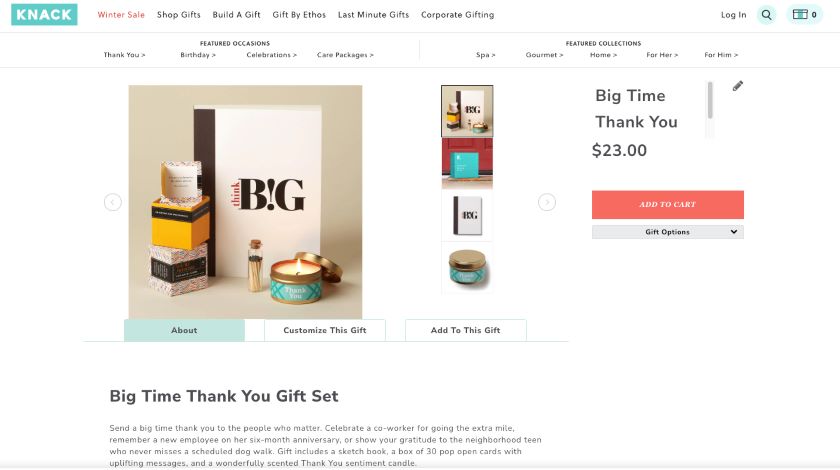
Gift bundles make gift-giving easy and allow you to sell a few items in a single transaction. (Source: Knack)
Knack, an online retailer that sells small knick-knacks and artisan goods, took a few of their items, bundled them together, and called it the “Big Time Thank You” gift bundle. The possibilities are endless—you can theme your gift bundles for any occasion. You might even feature your gift sets on a gift guide for extra promotion.
Subscription Boxes
You can also market your product bundles as subscription boxes. Typically, you start with a general theme for your subscription service, and from there, you can add any items from within that theme to your box.
Subscription bundles are a particularly lucrative marketing option for your bundles as customers sign up to receive them on a recurring basis. Additionally, the entire point of a subscription service is that the box will be a surprise, so you can add what makes the most sense for you and your inventory.
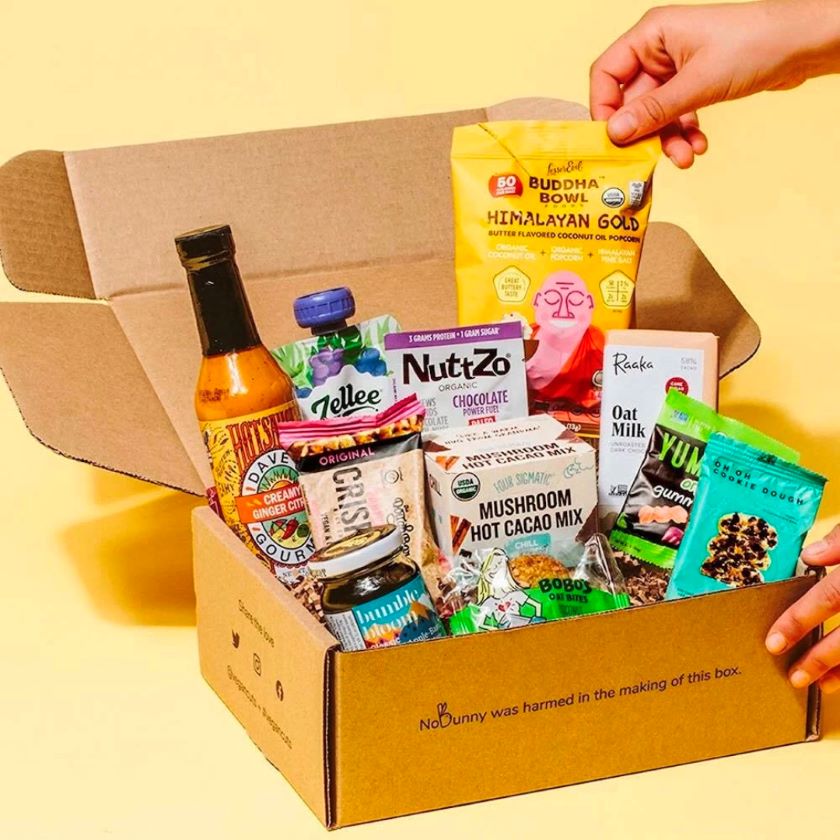
Subscription boxes allow you to sell bundles on a recurring basis. (Source: Well + Good)
Product Suggestion Bundling
Another way that you can market your bundles and inspire larger purchases is through product suggestions. You can either do this by suggesting items to bundle based on what people add to their carts, like in the image below, or you can add complimentary product suggestions to product pages.
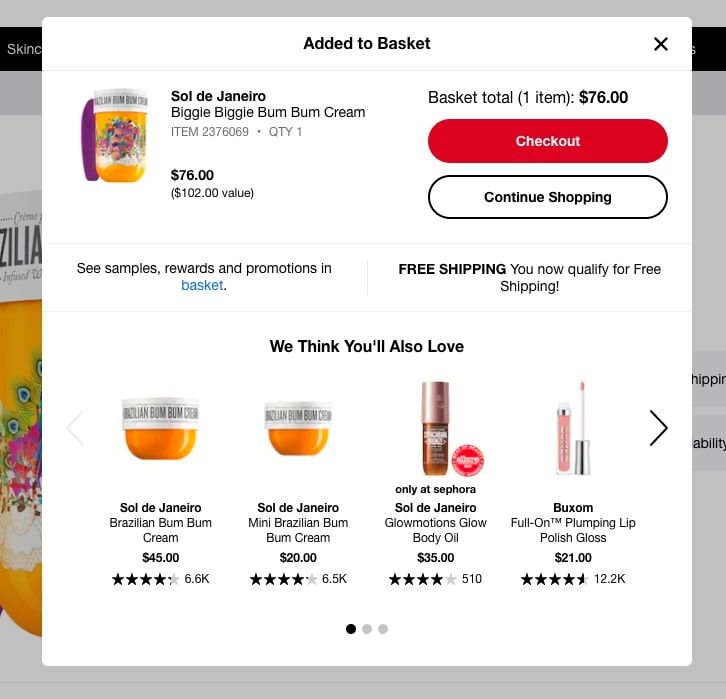
Related product suggestions are a great way to inspire additional purchases to bundle with an item that a customer is already interested in buying. (Source: Nosto)
This product bundling strategy is great because it starts the bundle with an item customers are already interested in buying and then uses that interest point to provide additional suggestions and inspire larger purchases.
Limited Time Bundles
With limited-time bundles, you might frame the offer as limited because the deal can’t last or you can tie the bundle to a specific occasion, like in the image below. This strategy will make people feel a greater sense of imperative to purchase your bundles while they last.
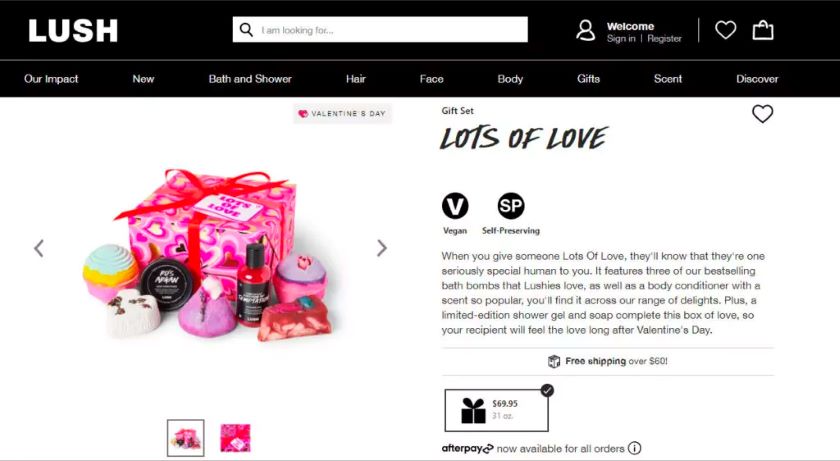
Making your bundle only available for a limited time or special occasion will inspire more buying incentive. (Source: Codup)
Clearance Bundles
You can also market your bundles as clearance bundles. This strategy will make it clear that you are offering your customers a great deal and it will help you clear out excess inventory.
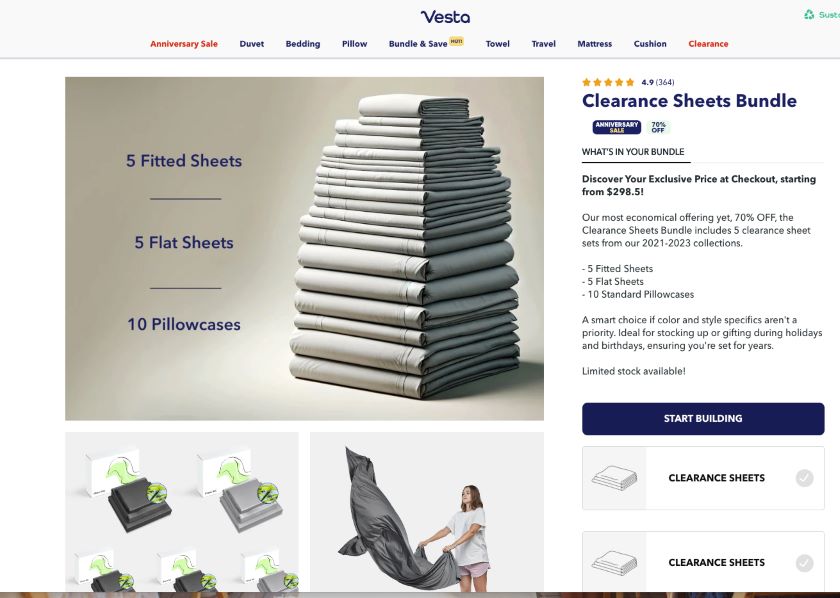
Get rid of your excess inventory by bundling them together to be bought as a highly-discounted clearance bundle. (Source: Vesta Sheets)
In the example above, Vesta is selling a clearance sheets bundle that includes 20 pieces of linen. The price of the bundle and the framing of it as a clearance deal show customers how much value they are getting. This allows Vesta to sell through their old sheets at a much faster clip than if they sold each clearance item separately.
Savings Bundles
Another product bundling strategy is framing them as a savings opportunity. Show customers that if you buy the bundle, they will save over time.
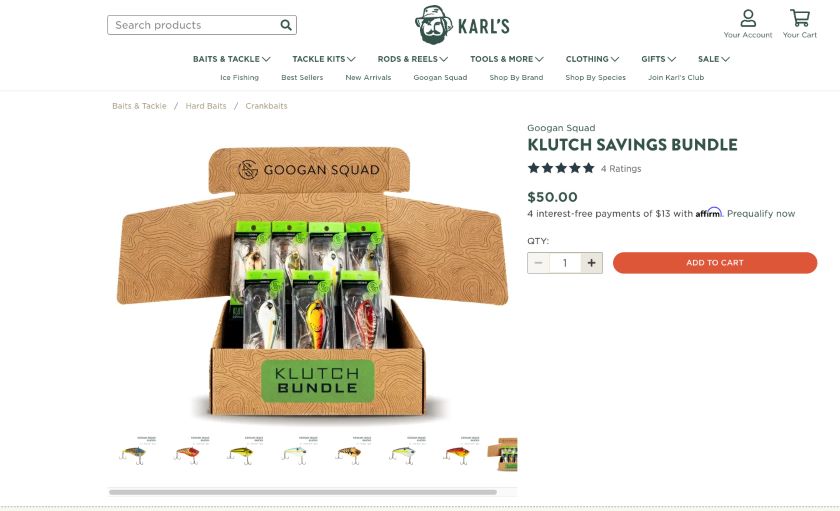
Pitch your bundle as a savings opportunity to inspire shoppers to buy more than they might have. (Source: Shop Karl’s)
For example, Karl’s named their bundle of fishing lures the “Klutch Savings Bundle,” convincing customers that if they bought the set of six lures together, they would get savings rather than if they simply bought one or two separately.
Surprise Bundles
You can also try marketing your product bundle as a surprise. In this strategy, customers buy a product bundle for a set price, but they don’t know what is inside. This is not only great for making people excited and drawing up interest, but it also gives you the flexibility to add whatever you want to the bundle.

Clear out inventory and draw up excitement with surprise bundles. (Source: Glitter Hippo)
Bulk Savings Bundles
Another bundling marketing strategy is to do bulk savings bundles. These bundles will typically include the bulk volume of a single or a few products—think 20+ items. The idea here is that you can sell the items at a close-to-wholesale price, giving customers a great deal and capturing a big sale for your business.
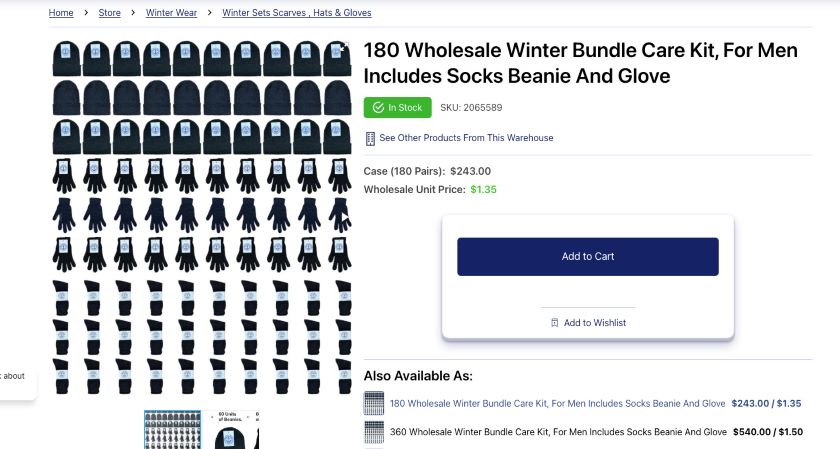
Offer extra savings to your customers with bulk bundling to inspire them to buy in large quantities. (Source: Wholesale Sock Deals)
This strategy works best for items with high margins that customers need on a routine basis, like toiletries or food items, as these are typically the only kinds of items that people need in mass.
How to Create Product Bundles
Creating product bundles to sell at your store only involves a three-step process. Take a look at our step-by-step product bundling guide below.
The first thing you will want to do if you want to introduce product bundles into your store is select your products. There are a few ways that you can do this:
- Look to your excess inventory: Product bundling is a great way to sell through items that you have in excess as you can sell multiple of these items in single transactions. If you have an excess of a certain product or a few products, consider bundling them.
- Consider your seasonal products: Bundling is also great if you have seasonal products that you are trying to sell through in a short period of time. If you have a large volume of seasonal products, you might bundle them to sell through them more efficiently.
- Use a bestseller as your anchor: Finally, you can look at a best-selling item and then choose either one or a few complementary products to sell with it. This is a great strategy if you have items that you are having a hard time selling or if you are introducing a new product and want to boost its appeal by bundling it with a best seller.
Ultimately, the products that you choose to include in your bundle will be based on the goals of your product bundling. Are you trying to get rid of inventory? Trying to promote something new? Have items that you need to sell quickly before their relevance expires? You can address all of these concerns by bundling. If you don’t have an explicit goal other than boosting sales, you can still consider the options above for added benefit.
From there, you will want to decide on a bundling strategy. Here are some ways that you can decide which is best for you and the products you have chosen:
- Pure: If the products in your bundle cannot function without each other, then you will want to sell them as a pure bundle where the items cannot be sold separately. In this case, you also will not necessarily need to offer a discount on the items.
- Mixed: If the products in your bundle can be sold separately, but they also function well together or complement each other, then you will likely want to do a mixed bundle with discounting or not.
- Discounted: If the items in your bundle are ones that you are trying to sell quickly or get rid of in mass, consider sweetening the deal with a discount bundle so you can create extra buying incentive.
- Choose your own bundle: If you have a lot of items you want to bundle and they are somewhat random and unrelated to each other, then a choose-your-own bundle will probably be your best bet.
Once you have selected your products and decided how you are going to bundle them, you should then consider your pricing strategy. Generally, you can choose to discount the items in your bundle for somewhere between 10% and 25% off their individual prices. Or, you can keep them at their original prices, just sold together. Whether you choose to discount or not will largely depend on how much demand there is for the items in your bundle, with lower-demand items benefitting the most from a deal.
Then, it’s time to promote your product bundles. As we looked at before, the way you frame your bundle—as a gift, subscription, limited edition, surprise, etc.—will play a major role in creating appeal. There are, however, a few additional ways that you can promote your bundles:
- Outreach marketing: Send texts and emails to your customers letting them know about your product bundles.
- In-store merchandising: Feature your product bundles in-store on your displays and cash wrap.
- Employee promotion: Train your staff to let customers know about your bundles and show them how they can upsell with product bundles if a customer comes in and is interested in one of the included products.
- Social media promotions: Feature your product bundles on social media as grid posts, stories, or videos.
- Ecommerce spotlight: Show your product bundles off online by featuring them on your online store. This might be a home page slide, a product bundle tab, or even just a key position in the product catalog that will make your bundle offering hard to miss for scrollers.
Bottom Line
Product bundling is a great way to boost your sales, offer customers a sense of value, and sell more merchandise. There are lots of different ways that you can use product bundling and nearly every business can adapt this strategy based on their circumstances. With the tools in the article, you are poised to successfully create and sell product bundles so your business can keep thriving.